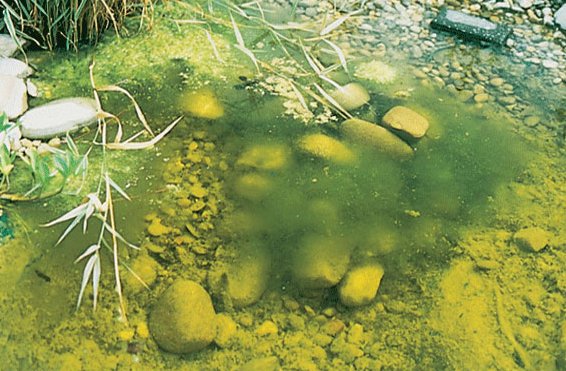How to Build a Pond Part 4 - Green Water Problems |
It
doesn’t take long for a newly built pond to go green. The green is caused by a
growth of algae in the pond and these tiny plants float around in the water
making it look green, even sometimes like pea soup. The algae need sunlight and
nitrates to grow, the more of these you have the worse it will be. Sunlight might not seem that common in Britain but it
doesn’t need to be blazing hot to make the algae grow and as the days get
longer from April to September things will get worse in the pond. Nitrate comes from fish poo, rotting plants or
leaves and garden or lawn fertiliser that comes into the pond as run off after
rain. |

If you want to control green water without using technology
then you need to minimise these sources of sunlight and nitrates. It will still
go a bit green in the summer but you can make it better by following these
tips. Shade the pond – have tall plants or fences that
block the sun in the hottest part of the day. Consider a pergola over the pond,
or a shade sail rigged across it. Use
plants – plants will use up nitrates from the water, the more you have the less
nitrates there will be. Make sure that they don’t drop leaves into the pond and
always cut them back at the end of the summer or they’ll add to the problems by
rotting down in the bottom. Plants will take a while to influence the water so
you might not see a difference in the first year after planting. Use less fish food – adding fish food is a massive
contributor to the nitrate build up. Don’t be tempted to overfeed your fish,
make sure that they eat everything, if they don’t then take off the waste food
before it sinks. You might use a feeding ring for this. Fertilizer – lawn feed and other fertilizers can
end up in the pond. Don’t use them near it or where the rain will wash it into
the pond. Ponds shouldn’t be at the lowest point in the garden but some are. |

If you want to be sure that your pond will stay clear all
the time then a pump, filter and ultraviolet light (UVC) are the answer. You’ll need a pump in the pond, this pumps the
water along a hose to a filter that is higher than the pond. Water then returns
to the pond, often down a waterfall. Usually the filter includes a UVC and it is this combination that will keep the water clean. 
If you can’t fit a box filter into this position then a pressure filter might be the answer. These can be sited lower than the waterfall as the water will leave the filter under pressure. Pond filters usually clean the water in two ways. There’s
mechanical filtration where a foam or (sometimes brushes) strains the lumps of
muck out of the water – a bit like a coffee machine. Then there’s biological
filtration where bacteria grow on media in the filter, these bacteria change
the fish waste (ammonia), into plant food (nitrates) Between the two processes
the water is made clean and safe for your fish. The UVC shines its ultra-violet light on the water as it
passes through the filter. This makes the algae particles clump together and
these can then be removed by filter foams making the water clear. Filters need to run all the time so that the bacteria can
grow. If you turn it off at night it will never work properly. The UV light has a bulb in it that needs to be changed once
each year in the spring, the foams can last for several years and can be
cleaned out in a bucket of pond water. A working pond filter that’s the right size will guarantee
that your water is clear. |
What Size of Filter do I Need? |
This
depends on the size of your pond and the type of fish you’ll keep. Bigger ponds
need bigger filters and if you keep bigger fish, that increases the demand too. To
work out the volume of water in the pond use our handy pond calculator. |
Then use our calculator below to work out the flow rate for your pump and filter in litres per hour. |
You
can use these figures to find a suitable filter. If you're not quite sure and need a
hand, just call our expert advisors on 01904 698800 and they’ll find
the right filter and pump for you. |
|  | |
What about Pond Treatments? |
|  | Some people prefer to use additive treatments to fix their green water problems. These are chemicals or natural substances that either kill the algae of starve it of the things it needs. Bear in mind that they are not a cure, they only get rid of the symptoms so you’ll have to keep dosing the pond regularly. There are lots of different ones, some liquid, some powders, some that dye the water slightly blue. You’ll need to know how much water is in your pond before you buy a treatment so use our calculator. |
All the treatments will tell you how much water they treat
and how often to do it. |
|
We like the sachet treatments like Bradshaws’ Get Rid of Green Water. These are water soluble pouches that you just throw in the pond once a week, you can’t overdose and there’s no fiddly measuring. For a full range of anti-green water products visit our website. Enjoy your pond. |
|
Free NEXT DAY Delivery over £50Excludes certain areas – click for details
1000s of Products in Stock
Price Match Guarantee
Next Working Day DeliveryOrder before 2pm









